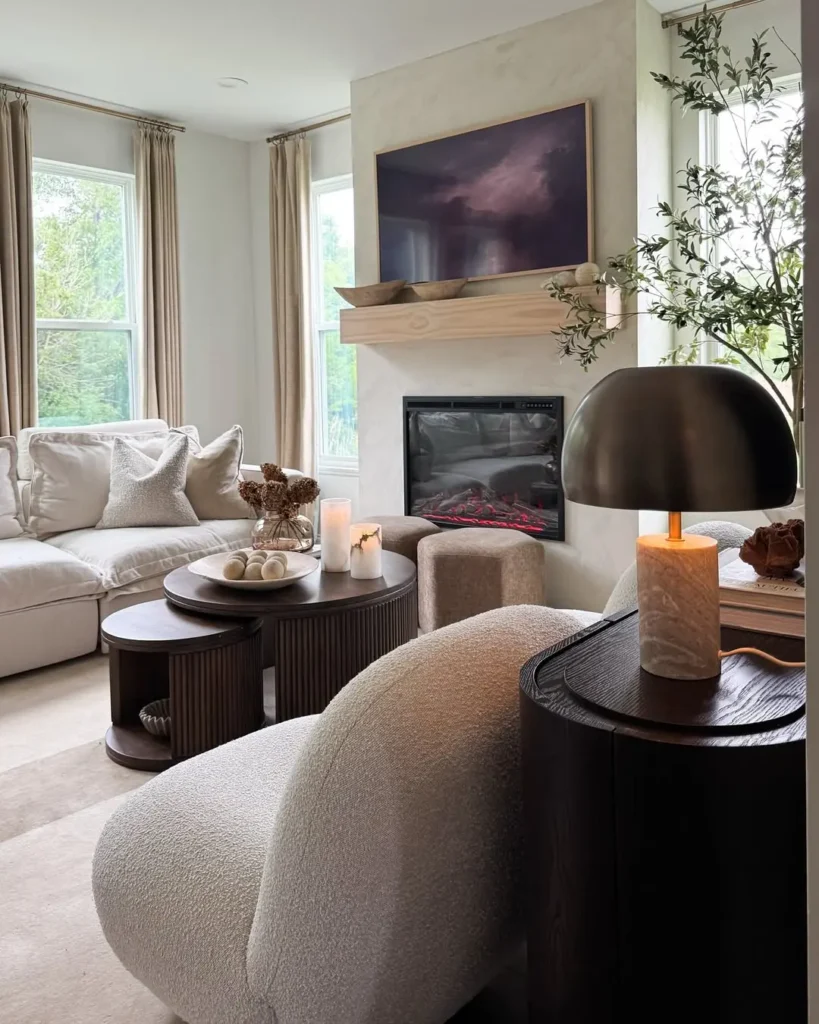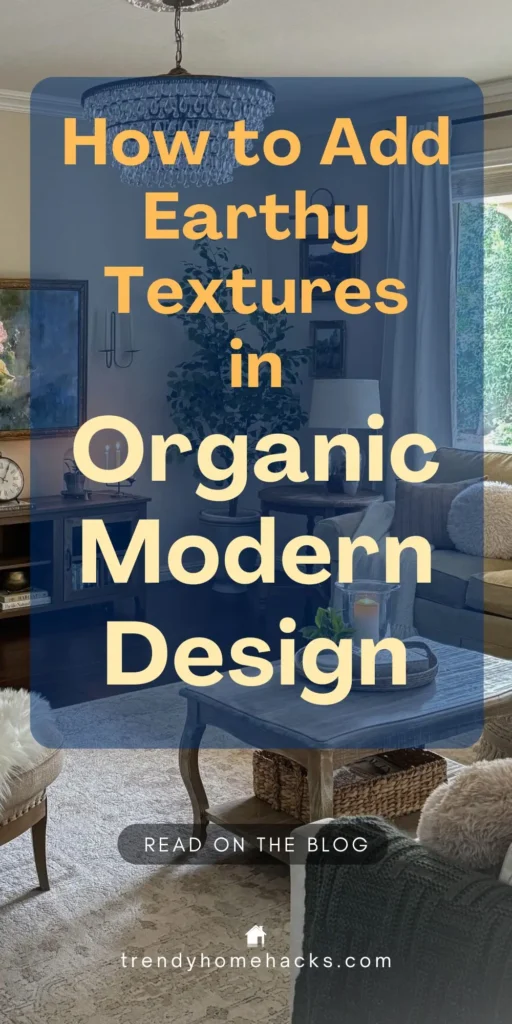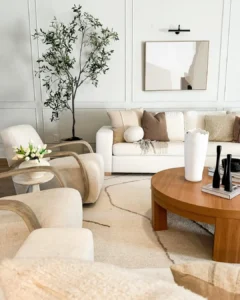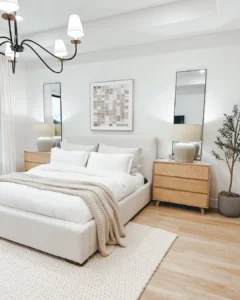There’s a quiet strength in a space that feels grounded. Calm. Effortless. Like it grew up out of the earth itself.
In this guide, you’ll discover how to include earthy textures in organic modern design in a way that feels natural, calming, and beautifully layered.
Organic modern design brings just that. Clean lines. Honest materials. And a sense of balance that feels both fresh and timeless.
But the secret ingredient? Texture.
Earthy textures bring depth to those soft neutral palettes. They invite warmth without clutter. Comfort without chaos. It’s how a room goes from styled to soulful.
Maybe you’ve already fallen for plaster walls or the raw edge of a wooden bench. Maybe you’re still figuring out how to layer without overthinking it.
Either way, this guide is here to help. Adding earthy textures in organic modern design is simpler than you might think.
We’ll explore real ways to layer earthy textures into your home. Think natural materials, tactile details, and styling that feels warm and effortless.
Why Earthy Textures Matter

Texture is what gives a space its feeling. It’s the whisper of a linen curtain in the breeze. The soft scratch of jute under bare feet. The quiet strength of stone against smooth plaster.
In organic modern design, textures aren’t just decorative—they do the heavy lifting.
Earthy textures help a space feel calm and connected. They reflect the natural world, which is never flat or one-note. Think about a walk through the woods. There’s bark, soil, moss, sunlight filtering through leaves. Every surface tells a story. Your home can do the same.
These natural layers keep minimalism from feeling sterile. They invite people to stay a little longer. To breathe a little deeper.
And there’s a practical side too. Clay walls help regulate humidity. Wool rugs naturally resist stains. Unfinished wood grows more beautiful with age.
When you bring in earthy textures in organic modern design, you’re adding both beauty and function. It’s where form and feeling meet.
If you’re looking to create a more serene environment, consider how you can incorporate natural elements to bring calmness into your interiors.
Later in this post, we’ll explore how to layer materials that feel natural and grounded. But if you want a broader perspective, here’s how to use natural elements to create an inviting organic modern home. Earthy textures in organic modern design offer a grounded, livable aesthetic that becomes richer over time.
How to Mix Earthy Textures with Other Styles
One of the joys of earthy textures is how easily they blend with other design styles. Whether you lean coastal, Scandinavian, traditional, or even industrial, natural materials bring softness and soul to a space.
The key is balance. If your home features modern minimalism, try adding a chunky wool throw or a reclaimed wood bench to break up the clean lines. In a more traditional space, swap heavy patterns for a linen slipcover or a woven rug to lighten the mood.
Keep your color palette cohesive. Earthy textures pair beautifully with warm whites, muted greens, dusty blues, and deep clay tones. Let the materials do the talking rather than mixing in bold patterns or shiny finishes.
Think of it like nature does—layered, imperfect, and effortless. A stone vessel in a classic kitchen. A jute runner in a hallway with ornate molding. The contrast is what makes it feel intentional.
Start small. One or two tactile pieces in a room can shift the tone entirely. This is especially true when working with earthy textures in organic modern design. Over time, you’ll find the mix that feels most like you.
Core Earthy Materials to Introduce
Layering earthy textures starts with choosing the right materials. These foundational choices are key when working with earthy textures in organic modern design. They’re the elements that bring character, comfort, and a sense of rootedness to your space. Each one tells a story—and together, they bring your organic modern home to life.
Clay and Plaster Finishes
There’s a quiet softness to clay and plaster walls. They diffuse light in a way that feels calm and warm. These finishes add texture without shouting.
Clay also has practical perks. It helps balance indoor humidity and resists mold. It’s natural, breathable, and beautiful.
Start small with a plaster accent wall or a fireplace surround. The texture adds soul to a space that might otherwise feel flat.
If you’re new to these finishes, you’ll love this guide on how to use natural elements like clay and lime to add quiet impact .
Stone and Marble
Stone grounds a space. Whether it’s honed travertine, raw concrete, or soapstone, the weight of it feels steady and enduring.
Use stone in unexpected places. Try a coffee table with a textural stone top. Add a marble tray to a wooden console. Even a pebble-filled planter can bring a tactile touch.
To see how these materials can elevate everyday spaces, explore how to design a bathroom with earthy stone textures and modern simplicity.
Raw or Reclaimed Wood
Wood adds warmth like nothing else can. Look for unfinished or reclaimed pieces—grainy oak, knotty pine, or a live-edge slab.
Whether it’s a timeworn bench by the door or rugged open shelves in the kitchen, these pieces carry stories into your space.
Use natural oil finishes to highlight the texture without adding shine. Imperfections are welcome—they make each piece feel real.
Natural Textiles and Fibers
Texture doesn’t stop at hard surfaces. Fabrics are one of the easiest ways to layer earthy materials.
Think linen drapes, wool throws, cotton bedding, and jute or sisal rugs. These pieces bring softness without fuss.
Mix thick and thin, nubby and smooth. Pair a bouclé armchair with a linen pillow. Lay a jute rug under a wool one.
For ideas that blend texture and tone, check out how to create a layered, earthy look in the bedroom using natural fibers.
Rattan, Wicker, and Handcrafted Ceramics
These lighter textures help balance heavier materials like wood and stone. They also add a hand-touched feel that makes a home feel personal.
Try a woven pendant light or a ceramic vase with a sandy finish. Rattan accent chairs or wicker baskets bring movement to the room.
Need help styling with these materials? Here’s how to use rattan and earthy decor to bring warmth and interest to your space.
Earthy Color Palette & Texture Pairing
The right textures need the right colors to shine. Earthy tones are the backdrop that lets those natural materials do their best work.
Start with a base of warm neutrals. Think soft white, creamy beige, warm taupe, and gentle gray. These tones create a clean, calming foundation.
Then layer in accent colors inspired by the natural world—muted clay, sage green, warm sand, or weathered terracotta. These shades feel grounded and organic, not trendy or overpowering.
Color and texture go hand in hand. A linen curtain in off-white catches light in a way that feels breezy and fresh. A rough plaster wall in pale ochre gives dimension without busy pattern. A mossy green wool pillow adds weight to a neutral sofa.
Keep contrast subtle. Focus on tone-on-tone layering, not stark differences. Combine smooth and coarse surfaces in similar shades for a look that’s both cohesive and tactile.
If you’re drawn to the soothing feel of these tones, learn how to use earthy colors to calm your space and your soul.
And if you’re still shaping your color story, here’s how to use neutral tones to build a beautiful organic modern look.
Tips for Layering Textures Effectively
Layering textures is where your home really starts to feel lived-in and personal. It’s the difference between a room that looks good—and one that feels good too. Here’s how to do it well, step by step.
1. Start Small and Build Slowly
You don’t need to transform a space overnight. Begin with one tactile element that speaks to you—a linen throw, a stone bowl, a rattan chair. Place it somewhere you pass by often.
See how it plays with the light. How it feels in the room. Then build around it slowly, adding new layers only when they feel right.
This method helps you avoid over-decorating. It also lets you develop a rhythm that’s natural to your space and your style.
2. Mix at Least Three Textures per Room
A good rule of thumb is to have at least three textures working together in every room. For example:
- A wool rug on hardwood floors
- A linen sofa with a chunky knit throw
- A ceramic vase on a stone or wood coffee table
This trio creates depth. The materials don’t need to match—they just need to feel harmonious.
If you’re not sure where to begin, look to natural pairings. Wool and wood. Clay and cotton. These materials already belong together.
Need simple ideas to get started? Try these affordable ways to introduce natural elements into your home.
3. Balance Rough and Smooth
Every room needs contrast. Without it, textures can blur into one another.
Pair rough finishes with something refined. A fluted wood cabinet beside a soft velvet chair. A weathered beam above polished plaster. These subtle differences help each material stand out.
Even if your color palette is neutral, contrast in feel will make the space come alive.
4. Anchor with Natural Light
Texture really shows its magic when light hits it. Think of how a clay wall glows in golden hour. Or how the weave of linen curtains dances in a breeze.
If you can, keep window treatments light and minimal. Use sheer drapes or natural shades like bamboo or rattan to soften sunlight without blocking it.
Place textured pieces near windows to catch natural light. A stone vessel on a sill or a rough vase beside your bed can look different at every hour of the day.
5. Blend Curves and Clean Lines
Organic modern design is a marriage of structure and softness. You want crisp architecture, but you also want shapes that feel more human.
Look for ways to mix geometric and organic. Try a curved clay lamp on a boxy nightstand. Or a round wool ottoman in a room with sharp-edged shelving.
This mix brings flow into a room and keeps it from feeling rigid.
6. Leave Breathing Room
Sometimes, texture needs space to speak.
Don’t crowd every shelf or layer every wall. Let one woven basket sit solo on a bench. Give that clay vessel a moment on an otherwise clean dining table.
Negative space isn’t empty—it’s intentional. It draws attention to the textures you’ve chosen and makes your home feel calm rather than chaotic.
Room-by-Room Texture Strategies
Earthy textures work differently in each part of the home. Some rooms need softness. Others call for contrast or structure. Here’s how to create balance from room to room—without losing that grounded, organic feel.
Living Room
This is often the heart of the home. It should feel inviting, layered, and lived-in.
Start from the ground up with a textured wool or jute rug. Anchor your seating with a raw wood coffee table or a travertine top. Add softness with a linen slipcover sofa and woven baskets for storage.
Use ceramics, books, and natural candles to bring subtle tactile interest to open shelves.
For deeper inspiration, explore how to create a cozy yet minimal living space with texture and tone.
Kitchen and Dining Room
In these high-function spaces, texture brings warmth without sacrificing practicality.
Try a reclaimed wood dining table or open shelving made from live-edge planks. Use handmade ceramic bowls and stoneware plates for everyday beauty. A rattan light fixture or jute runner adds softness without getting in the way.
If your kitchen feels too modern or cold, balance it with warm wood, clay tile, or woven stools.
Looking to redesign these areas? Learn how to create an organic modern kitchen with natural layers and how to curate texture in your dining space.
Bedroom
This is your place to rest and restore. Keep textures soft, grounding, and comforting.
Layer a low-pile wool rug underfoot. Use linen sheets, a cotton quilt, and a chunky knit throw. Mix nightstands—maybe one in reclaimed wood, the other in rattan or stone.
Even the headboard is a great place to add texture: choose bouclé upholstery, slatted wood, or raw-edge panels.
Want to dive deeper? Here’s how to build a serene, earthy bedroom with layered materials.
Bathroom
Texture in the bathroom adds spa-like calm. Try a clay or stone tile wall, a matte concrete sink, or even just a handmade ceramic soap dish.
Add texture with soft goods too—like waffle weave towels, a linen shower curtain, or a wooden stool by the tub.
Storage baskets, woven trays, and earthy bath mats all help round out the space.
Need a full how-to? Learn how to design an earthy, elegant bathroom from scratch.
Entryway
This is your first impression. Keep it simple but full of character.
Use a reclaimed wood bench or a curved ceramic planter. Add a woven tray for keys and a jute runner to soften the floor. Hang a round mirror above a raw wood console to blend structure and softness.
Here’s how to design an entryway that blends minimalism with texture and warmth.
Caring for Earthy Materials in Organic Modern Design
Natural textures are beautiful—but they also deserve thoughtful care. When you choose raw, earthy materials, you’re not just decorating. You’re bringing nature inside. With the right maintenance, these elements only get better with time.
Choose Finishes That Age Gracefully
Many earthy materials—like untreated wood or clay—develop a patina as they age. That’s part of their charm. If you prefer a little more protection, choose finishes like hardwax oil, beeswax, or limewash. These seal without creating a high-gloss look and let the texture stay visible.
Clean Gently and Naturally
Stick to gentle, natural cleaning products. Harsh chemicals can strip or discolor porous materials like stone, terracotta, or wood.
- For wood: Gently clean with a soft cloth and mild soap, then nourish the wood from time to time with a natural oil finish.
- For stone: wipe with warm water and a pH-neutral cleaner.
- For textiles: vacuum jute or wool rugs regularly, and spot clean with water and vinegar as needed.
Let Imperfection Be Part of the Story
Scratches, worn edges, soft stains—these are signs of a home that’s loved. Don’t over-polish or over-correct. Let natural wear bring character and authenticity to your space.
If your goal is a home that feels warm and lived-in, these little imperfections only add to that charm.
Stay Curated, Not Cluttered
Earthy textures shine in simple, uncluttered spaces. As you add pieces over time, keep editing. If something feels too fussy or artificial, let it go.
Want more tips on styling with intention? Here’s how to bring natural elements into your home in a thoughtful, approachable way.
DIY & Styling Ideas for Earthy Texture in Organic Modern Design
Sometimes the most beautiful updates are the ones you make with your own two hands. If you’re looking to add earthy textures in simple, meaningful ways, these DIY and styling ideas are a great place to start.
1. Paint a Plaster Accent Wall
Give one wall a soft, natural finish with a limewash or clay-based plaster. The texture catches light beautifully and adds instant depth. Stick to warm neutrals like sand, bone, or soft terracotta.
This works especially well in living rooms, bedrooms, or even entryways.
2. Layer Natural Fiber Rugs
Try layering a flatwoven jute or sisal rug underneath a wool or cotton rug. The base adds a rough, earthy texture while the top layer brings softness underfoot.
Mixing fibers is a simple way to ground a room without committing to new furniture.
3. Upcycle Wood with Natural Oils
Find an old wooden piece at a thrift store or flea market—a bench, a mirror frame, a side table. Sand it down and seal it with tung oil or hardwax oil. You’ll bring out the wood’s natural grain and give it new life.
4. Create a Ceramic Grouping
Pick up a few handmade ceramic vases or bowls in varied shapes and textures. Cluster them on a shelf, mantel, or sideboard. Leave some empty, or add dried grasses for an organic touch.
Choose matte, sandy finishes in muted tones for a collected, calming look.
5. Style with Woven Accents
Swap out plastic or metal bins for woven baskets. Add a rattan tray to your coffee table or nightstand. Hang a wicker pendant light above your dining table for a dramatic but earthy effect.
Conclusion: Let Texture Tell the Story
Earthy textures are what make an organic modern home feel alive. They soften the sharp lines. They ground the space. They invite you—and your guests—to slow down and settle in.
Start small. Layer slowly. Let your materials breathe.
Over time, you’ll create a home that doesn’t just look beautiful, but one that feels calm, collected, and truly yours. All thanks to the quiet power of earthy textures in organic modern design.
If you’re just getting started or want to see how all the pieces come together, explore our complete guide to organic modern design principles and styling tips.
Happy decorating!
Frequently Asked Questions about Earthy Textures in Organic Modern Design
What are some examples of earthy textures in organic modern design?
Earthy textures include natural materials like raw wood, linen, jute, wool, clay, stone, and rattan. These materials bring a tactile, grounded feel to your space and help create the warm, serene look that defines organic modern interiors.
How do I mix textures without making a room feel cluttered?
Stick to a neutral color palette and focus on contrast in texture, not color. Layer no more than three to five textures in a room, and leave breathing room between decor pieces. Choose quality over quantity.
Can I use earthy textures in a small space?
Yes! Earthy textures can actually make a small space feel more inviting and layered. Use lighter tones, woven textiles, and a few standout natural materials like a wood stool or ceramic lamp to add warmth without taking up visual space.
What’s the easiest way to start adding earthy textures?
Start with textiles. A jute rug, linen pillow covers, or a cotton throw instantly adds depth. Then layer in small items like a wood tray, a ceramic vase, or a woven basket. Over time, you can introduce larger pieces like a wood table or plaster wall.
Like this post? Pin it so you can come back to it later!




